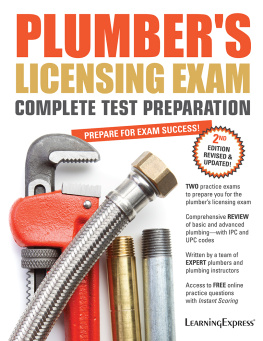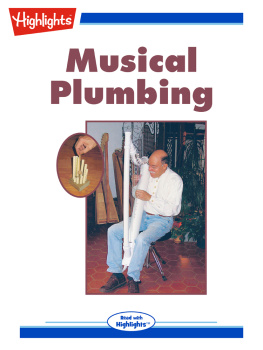chapter 1
Different Plumbing Codes and Abbreviations
CHAPTER SUMMARY
It is important at the outset to note some of the differences between the International Plumbing Code and the Uniform Plumbing Code. The principles of hydraulics and physics work the same everywhere on Earth, but the opinions and experience of the folks who write these codes vary greatly. A single code written by the same body will differ from one edition to the next as changes in administrative practices, updates of equipment, and the results of recent studies shed new light on the operation of plumbing systems. Following any valid plumbing code will result in a well-designed plumbing system. However, it is important that you have a copy of your local code with you and follow it so that you work within the boundaries of your jurisdiction.
Learning Objectives
Recognize code differences
Understand the reasons for inconsistencies
Become aware of your local code
Key Terms
air admittance valve
backow preventer
hoar frost
/ % design temperature
stack vent
vent stack
weir
General Regions Served by the IPC and the UPC
Many states have adopted the International Plumbing Code (IPC) created by the International Code Council, which is headquartered in Washington, D.C. The IPC is used primarily throughout the eastern, midwestern, and southern United States.
The International Association of Plumbing and Mechanical Ofcials (IAPMO) is the creator of the Uniform Plumbing Code. Home base for IAPMO is in Southern California. The UPC has been adopted in many western, northwestern, and northern midwestern states.
The adoption of different codes in different geographical regions is simply a result of the growth of the country from east to west, as well as the changing in uences over time in the differing regions. Cities grew large must faster in the east, so the necessity of codes was evident more quickly in the east. Western cities grew much later and the technology of plumbing was already evolving. Cities and states in the west started new codes with fresh research. The eastern cities and states continued to build on their established code that was already being used successfully. In spirit, the codes achieve the same end of creating plumbing systems that protect the health of the population. The differ ences are in the details.
Areas of some states have adopted mixtures of the two codes and others have their own unique code, usually based on either the IPC or the UPC. Code adoption is not necessarily consistent within a state. Many individual municipalities and counties have their own version of a code. That is why it is important to check with your local government ofce and obtain a copy of the code on which you will be tested. There is no substitute for getting the correct information direct from the source.
JOB CONNECTION
After completing the renovation of several apartment buildings in a medium-sized city in Ohio, Ace Plumbing Company will be ready to move on to the townhouse construction jobwon through the efforts of the owner, Carlos Mendez, and the company estimator, Sophia. The project happens to be just across the state line in Indiana. Sophia had the additional challenge of applying the UPC code, which is used in Indiana, rather than the IPC code, with which she is more accustomed.
ALERT
Even if you believe you have followed the code on a particular feature of an installation, the Jurisdiction Having Authority makes the final judgment about whether the installation meets code. Many sections of a code are subject to interpretation. The Jurisdiction Having Authority, which may be a building inspector, a plumbing inspector, a code enforcement officer, or another inspector with a different title, makes the final decision.
Differences between the IPC and the UPC
In addition to geographic variations between the IPC and UPC, there are differences that have been formed by hard research and also differences that are based on the experience and opinions of those charged with writing a code. This section provides a broad outline of some of the most important areas of difference.
Drainage Vents
There is one dramatic difference between the codes concerning venting. The UPC requires all vents in a system to terminate through the roof one way or an other. Vents may pass through and end above the roof individually, or they can be connected to a stack vent or vent stack that goes up through the roof. The IPC allows the use of air admittance valves (Figure 1.1) throughout a system as long as at least one vent goes up through the roof. An air admittance valve is an air inlet valve that is installed where a vent pipe normally would be installed. They are commonly located under cabinets, as in the case of vanities and kitchen cabinets, or they can be installed within a wall behind a grille to allow the intake of air and access for servicing. Air admittance valves allow the plumber to easily vent a fixture without running a pipe all the way through framing members to penetrate the roof. This results in significant savings in labor and material, especially when plumbing is added to an existing home where all the surfaces are finished. (Refer to IPC 917.3 and 917.7; UPC Chapter 9 Introduction)
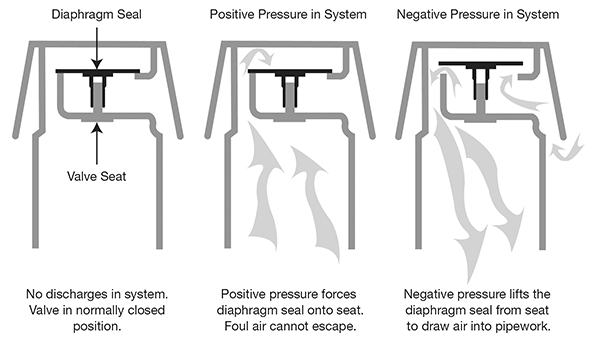
Figure 1.1 Air Admittance Valve
Air admittance valves are different from mechanical vents, which are commonly referred to as cheater vents. Air admittance valves are closed by gravity pulling a disc closed. Mechanical vents are closed by a lightweight spring. Gravity is far more dependable than a spring. Therefore, mechanical vents are not allowed under any plumbing code.
Dishwashers
Under the UPC, a dishwasher drain hose is required to connect to an air gap device above the flood level rim of the associated fixture before it continues to the drainage piping on the inlet side of the trap (Figure 1.2). This is to prevent the backflow of sewage into a dishwasher in the event of a blockage in the drainage piping. The IPC recognizes that currently manufactured dishwashers are fitted with an integral backflow preventer in the water supply line and no further air gap is required (Figure 1.3). (Refer to IPC 802.1.6; UPC 807.4)
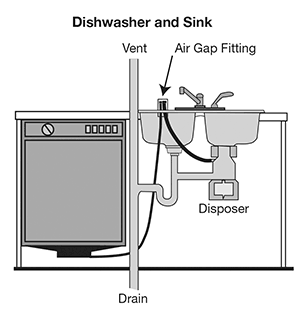
Figure 1.2 Air Gap for a Dishwasher Drain
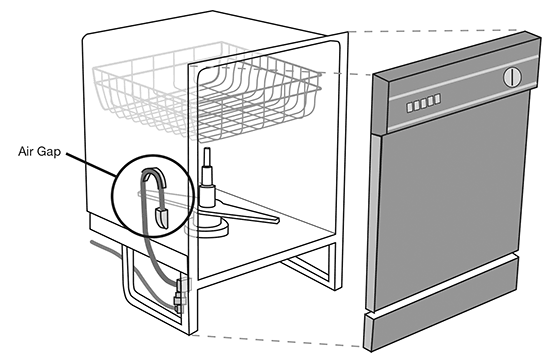
Figure 1.3 Air Gap for the Dishwasher Supply
Water Heater
The UPC goes into great detail concerning the proper venting of water heaters. If the UPC is the code used in your area, make sure to study Chapter 5 in your codebook. The IPC doesnt cover the venting of water heaters. The IPC leaves that to another ICC code. (Refer to UPC Chapter 5)
Water Distribution
Both codes are equally conscientious in regard to water distribution systems. The primary goal is to ensure the safety of the public. The prevention of cross-connections and backflow are covered carefully in both codes. The secondary concern of both the UPC and the IPC is the adequate supply of water to all of the fixtures in a building. (Refer to IPC Chapter 6; UPC Chapter 6)
Drainage Systems
The requirements for drainage systems in both the IPC and the UPC generally are similar, but there are a few differences. Both codes allow a kitchen sink and a shower to have a 1 / -inch trap. However, the IPC allows the drain for a kitchen sink to be 1 / inches, while the UPC requires a 2-inch drain for a kitchen sink. The IPC allows a 1 / inch drain for a shower, but the UPC requires a 2-inch drain.
Next page
